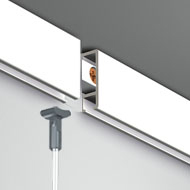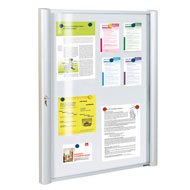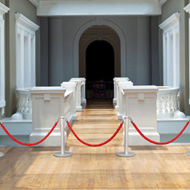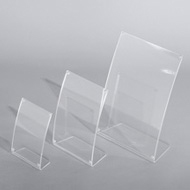7 Tipps für ein gutes Türschild
Dienstag, 1. Mai 2018
Ein praktisches und optisch ansprechendes Türschild ist mit diesen Tipps leicht zu erstellen.

Große und schwere Türschilder sind eindeutig besser an der Wand aufgehoben als an der Tür. In der Regel ist die Wand anzubohren, um spezielle Halter anzubringen. Bei kleineren Schildern bietet es sich an, diese an der Tür zu befestigen. Dies ist sowohl durch Schrauben als auch durch Kleben möglich. Entscheiden Sie sich für eine unsichtbare Montage oder Halter, welche die Eleganz des Schildes unterstreichen.
Berücksichtigen Sie beim Format des Türschildes den Umfang der Botschaft, die darauf steht. Diese sollten in einem harmonischem Verhältnis zueinander stehen. Aber auch praktische Überlegungen sind angebracht. Schilder im Format DIN A4 (210 x 297 mm) können Sie einfach mit jedem üblichen Drucker gestalten. Das Format 148 x 148 mm ist ein Klassiker und ebenfalls einfach selbst zu bedrucken. Bei größeren Türschildern ist es meist komplizierter, die Einleger im eigenen Haus herzustellen.
In ruhigen und abgelegenen Fluren sind Systeme sinnvoll, die verhindern, das Unbefugte die Schild-Beschriftung austauschen. Die Manipulationssicherung wird z.B. mithilfe von Madenschraube, Federverschluss oder Handling-Saugnapf gewährleistet. Bei den meisten Türschildern im Innenbereich ist diese Vorsichtsmaßnahme überflüssig, da sich niemand unbeobachtet daran zu schaffen machen kann.

1. Lesbarkeit
Das Türschild dient der Information. Fremde sollen ohne Mühe erkennen können, wer oder was sich hinter der Tür befindet. Kunstvolle und verschnörkelte Schriften sind nicht angebracht. Entscheiden Sie sich für klare deutliche Druckbuchstaben in einer angemessenen Größe. Achten Sie auf einen großen Farbkontrast zwischen dem Hintergrund und der Schrift.2. Austauschbarkeit
Heute Büro - morgen Konferenzraum. In der Praxis ist es üblich, Räume immer wieder anders zu nutzen. Aus diesem Grund sind Türschilder mit Einleger eine optimale Lösung. Die Beschriftung in so einem Wechselrahmen tauschen Sie bei Bedarf mit wenigen Handgriffen aus. Wenn dies häufig und schnell geschehen muss, sind Systeme mit Magnetverschluss oder Klapprahmen eine gute Lösung. Auch das Einsteckschild "Click Sign" hat sich bewährt, wenn die Beschriftungen häufig ausgetauscht werden sollten.3. Abdeckung
Transparente leichte Abdeckungen aus Kunststoff schützen den Papiereinleger und verhindern dessen Verschmutzen. Acryl ist lichtbeständig, aber etwas empfindlich gegen Kratzer. Polystyrol (PS) verkratzt nicht so schnell, neigt aber zum Vergilben, wenn UV-Licht darauf fällt. Polycarbonat ist mit Abstand am unempfindlichsten, verträgt aber ebenfalls UV-Licht schlecht. Dies ist aber bei Türschildern im Innenbereich eher unwichtig.4. Optik
Mit oder ohne Rahmen – das ist nicht nur Geschmacksache. Der Rahmen schützt in der Regel die Türschild-Kanten und verhindert, dass Staub oder Feuchtigkeit an den Einleger gelangt. Das Interieur spielt bei der Entscheidung auch eine wichtige Rolle. Ein Rahmen aus Aluminum gibt dem Türschild etwas gediegenes. Rahmenlose Schilder wirken leicht und schwebend. Gewölbte Schilder vermitteln immer den Eindruck von Eleganz. Sie heben sich aus der Masse von Türschildern deutlich hervor.
5. Montage
Große und schwere Türschilder sind eindeutig besser an der Wand aufgehoben als an der Tür. In der Regel ist die Wand anzubohren, um spezielle Halter anzubringen. Bei kleineren Schildern bietet es sich an, diese an der Tür zu befestigen. Dies ist sowohl durch Schrauben als auch durch Kleben möglich. Entscheiden Sie sich für eine unsichtbare Montage oder Halter, welche die Eleganz des Schildes unterstreichen.
6. Größe
Berücksichtigen Sie beim Format des Türschildes den Umfang der Botschaft, die darauf steht. Diese sollten in einem harmonischem Verhältnis zueinander stehen. Aber auch praktische Überlegungen sind angebracht. Schilder im Format DIN A4 (210 x 297 mm) können Sie einfach mit jedem üblichen Drucker gestalten. Das Format 148 x 148 mm ist ein Klassiker und ebenfalls einfach selbst zu bedrucken. Bei größeren Türschildern ist es meist komplizierter, die Einleger im eigenen Haus herzustellen.
7. Manipulationssicherheit
In ruhigen und abgelegenen Fluren sind Systeme sinnvoll, die verhindern, das Unbefugte die Schild-Beschriftung austauschen. Die Manipulationssicherung wird z.B. mithilfe von Madenschraube, Federverschluss oder Handling-Saugnapf gewährleistet. Bei den meisten Türschildern im Innenbereich ist diese Vorsichtsmaßnahme überflüssig, da sich niemand unbeobachtet daran zu schaffen machen kann.




















































